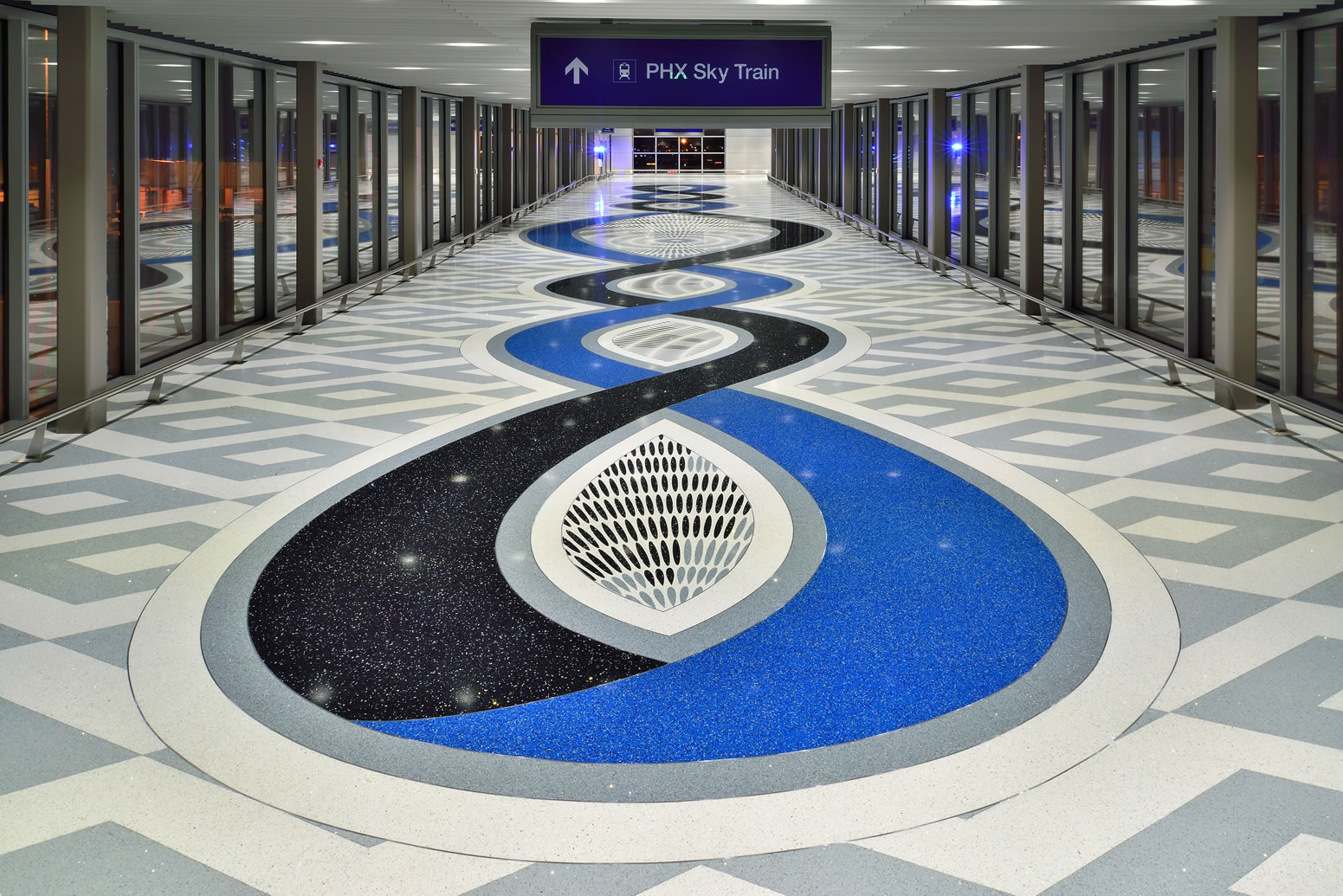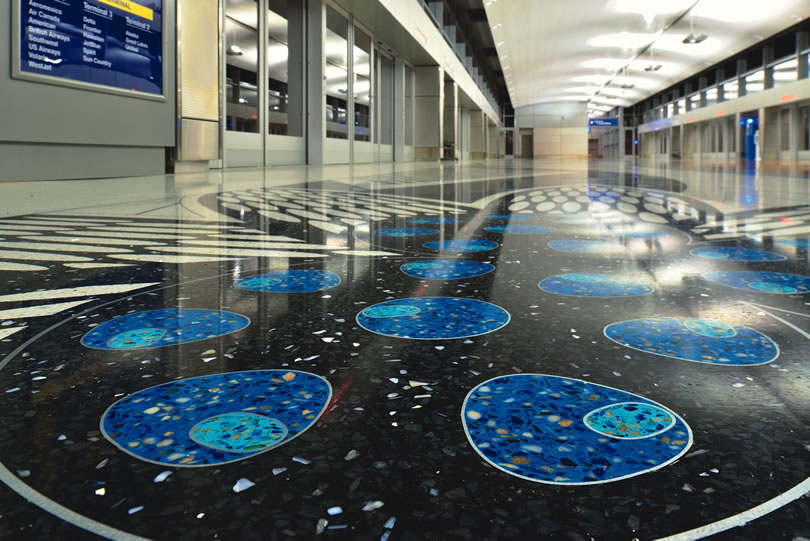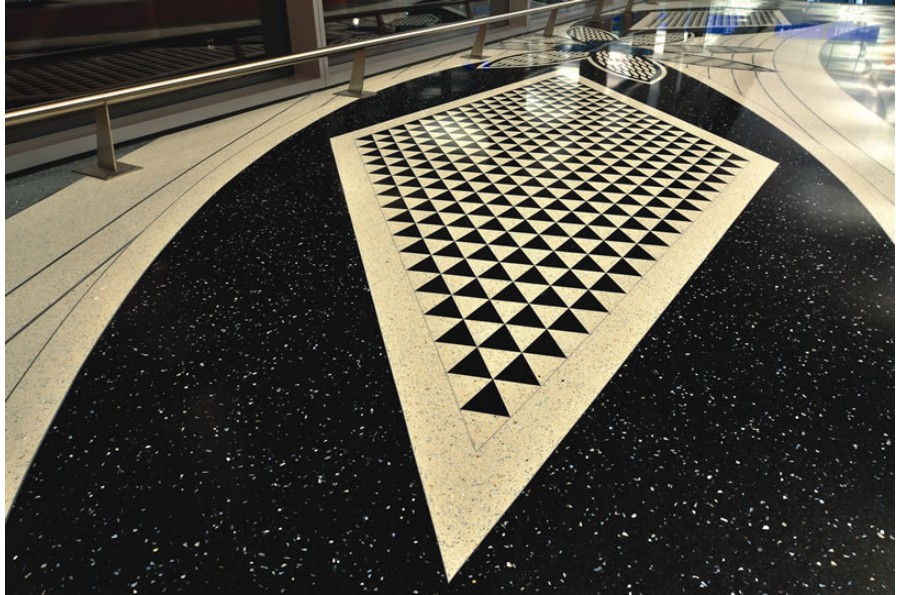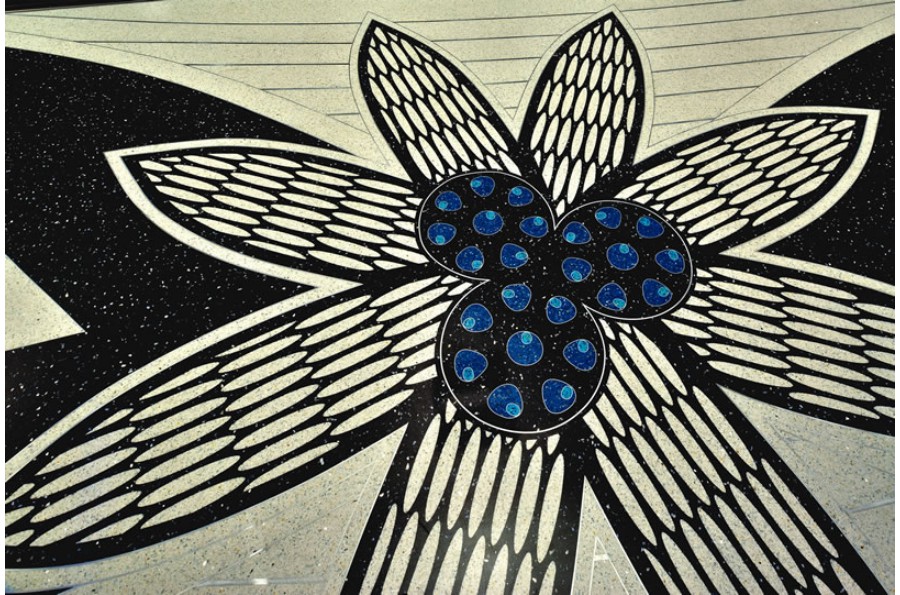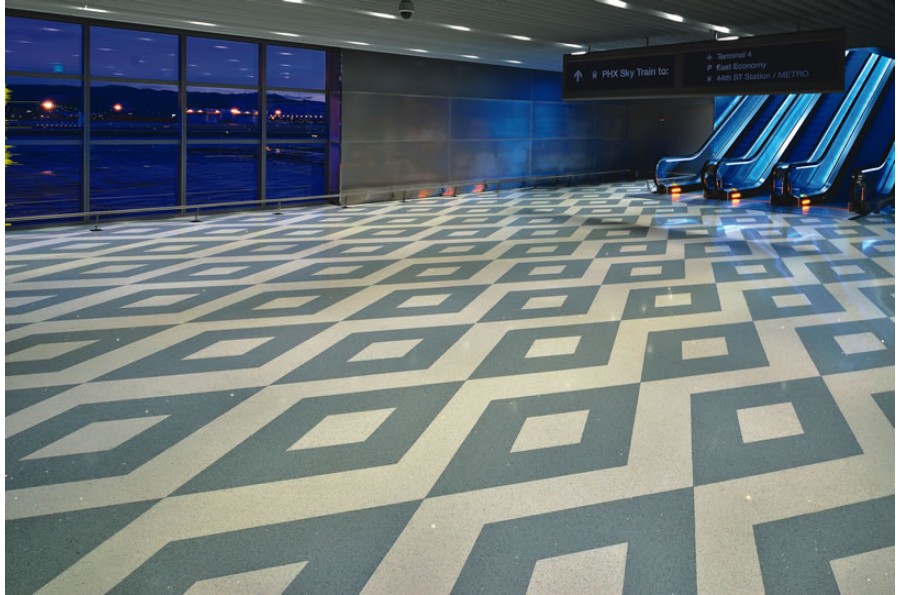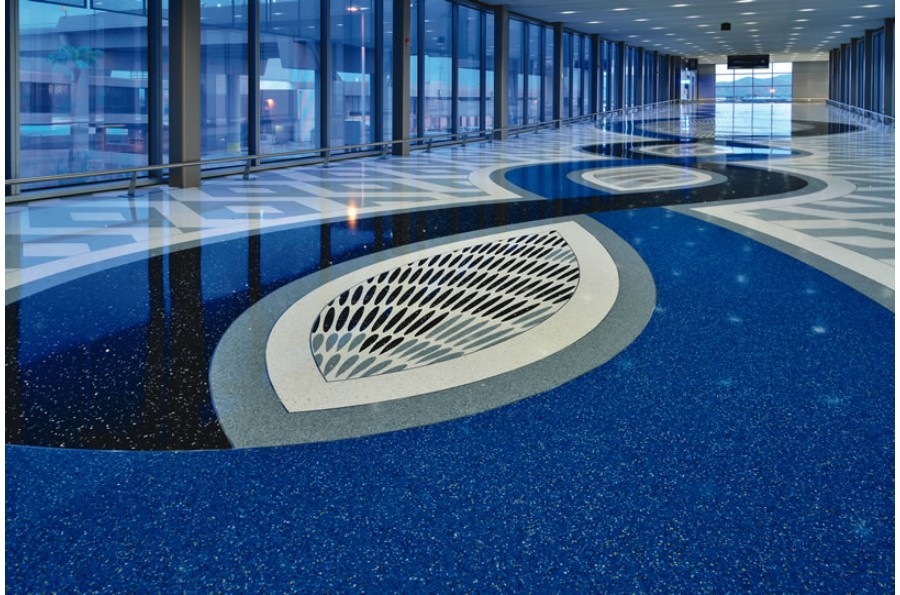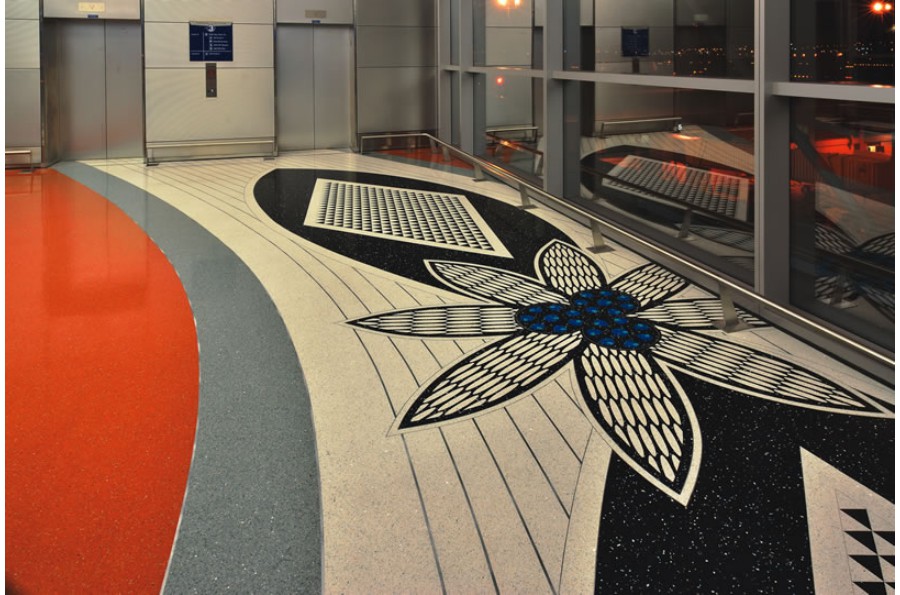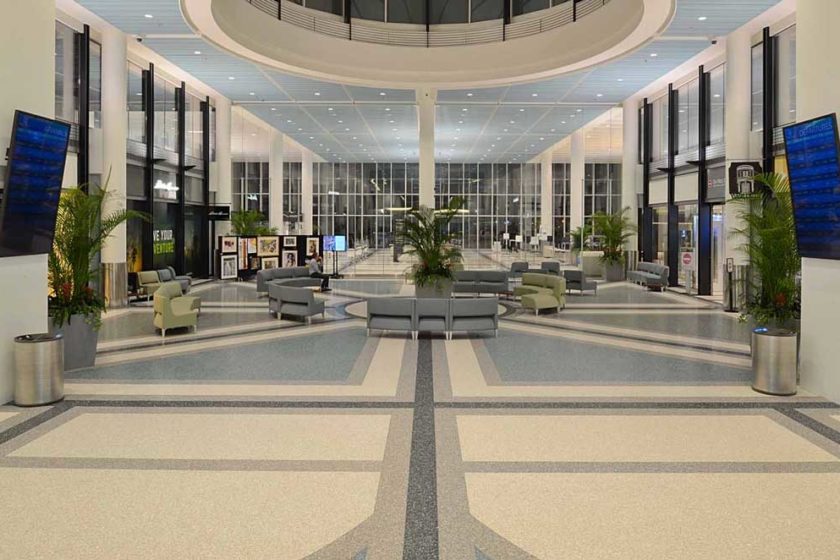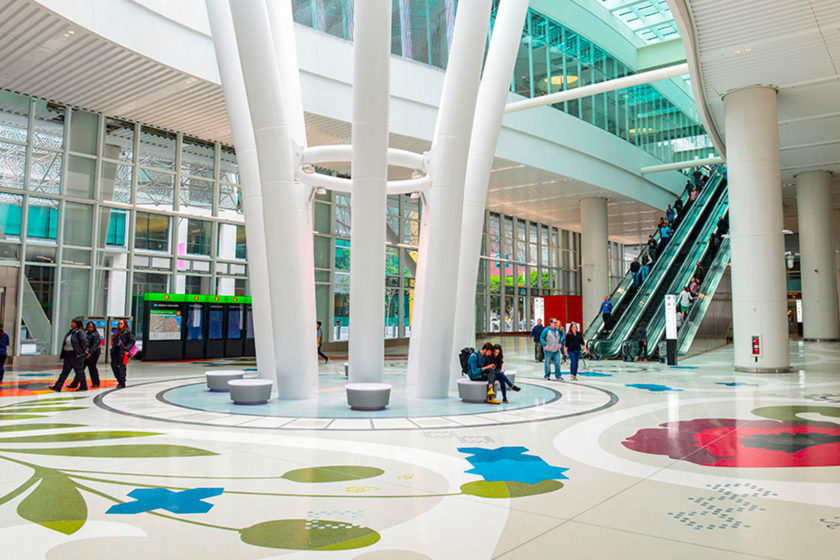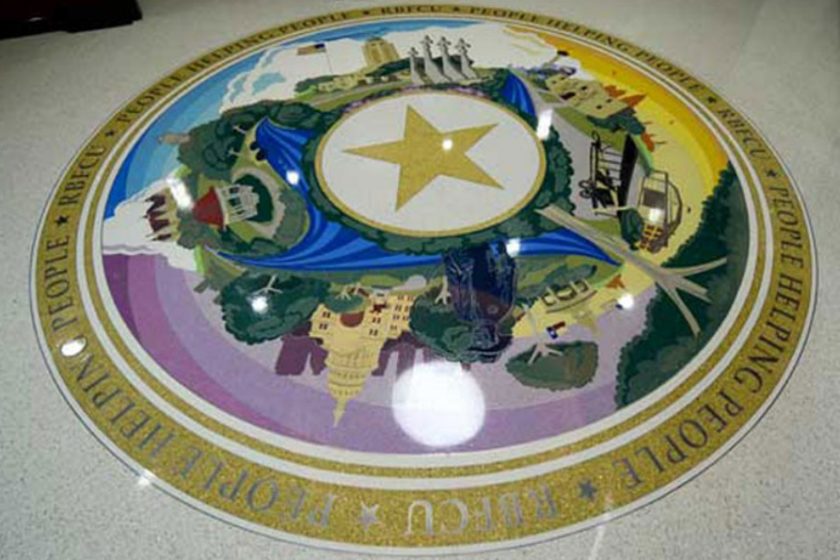At Phoenix Sky Harbor International Airport
When Navajo and Acoma textile artist Janelle Lane Stanley answered her first call-to-artists to design a public art project, she had just graduated from college. The commission awarded to her was to design a large terrazzo floor for a platform in Phoenix Sky Harbor International Airport’s automated train system.
“It was amazing to watch her go from a hands-on studio craft to trust the process to translate her vision to such a large scale project,” said Rebecca Blume Rothman, public art project manager with City of Phoenix Office of Arts and Culture. “It was also very inspiring to see her work have this level of success.”
The collaborative process of the artist with the terrazzo contractor resulted in the translation of Stanley’s original hand-drawn design, inspired by traditional Navajo weaving and Acoma pottery patterns, to two award-winning terrazzo floors covering a total of over 16,000 square feet.
Ms. Stanley was one of five artists selected in 2008 by the Phoenix Public Art Program to create a series of floors in the platforms and foot bridges of the Sky Train system, with aviation percent-for-art funds. Two years into the process, Ms. Stanley was offered another commission, to design a foot bridge to the train station, completing the last phase of the project and the last floor in the award-winning series.
The terrazzo contractor on the project, CORRADINI Corp. of Fountain Valley, Calif., has been awarded the industry’s highest honor, the Job of the Year from National Terrazzo & Mosaic Association (NTMA), announced April 1 at NTMA’s 92nd annual national convention in New Orleans. The project was chosen based on design, scope and craftsmanship from among 39 nationwide terrazzo projects submitted.
Design and Durability
This year’s winning project, with 24,000 square feet of epoxy thin-set terrazzo in seven colors, incorporates over 9,000 water-jet cut terrazzo and black granite shapes.
“It’s poured-in-place, hand-made art on a grand scale,” said Chris Corradini, president of CORRADINI Corp., a fourth generation family company founded in 1924. “This project shows the extreme of what terrazzo can do; it really portrays what you can do with it, in colors, shapes and patterns,” Corradini said.
Corriadini reported that someone had asked him if it’s more expensive to do vibrant colors like the ones in these floors, and since it’s not, why they’re not done more.
“That’s a good question, as it does not add to the cost to use a vibrant color over a neutral color; a truly designed floor enriches an environment, makes a floor come to life so people really see it,” said Corradini, whose 550,000-square-foot installation at the Los Angeles International Airport was NTMA’s 2014 Job of the Year.
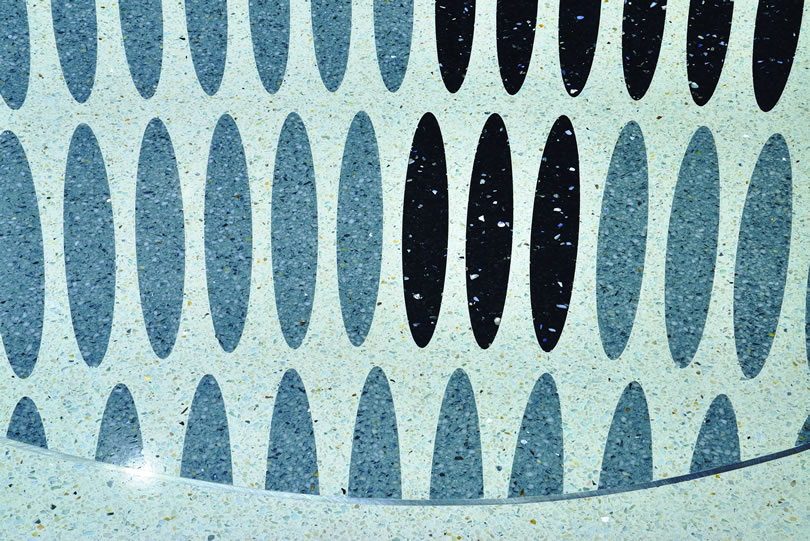
For the Phoenix Public Art program, a terrazzo floor offers the opportunity to bring grand-scale visibility to painters, printmakers and weavers and to present a permanent, low-maintenance work of art that a public of literally millions each year can enjoy up close.
“It’s a fabulous way to translate art to the built environment,” said Rothman, project manager for all six terrazzo art installations at the airport and several other public art projects in terrazzo. “It’s a wonderful material with not only great colors, but also minimal maintenance and extreme durability, which is amazing for public art.”
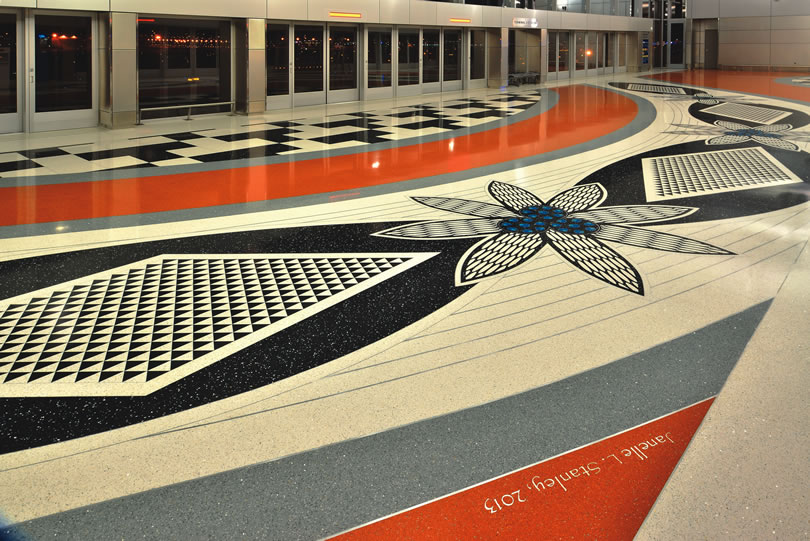
Tradition and Today
Ms. Stanley had just completed her bachelor’s degree in fine art with an emphasis on Fibers at Arizona State University when she submitted her proposal to design the floor. Up to that time, she had specialized in surface design: embroidery, printed fabric, and textile screen printing, systematic processes that create patterns. She often creates by hand with these processes and enjoys adding embellishments to her works.
“I was inspired as a child by watching and helping my extended family prepare the wool for weaving, which created a bond to natural fibers and textiles,” Ms Stanley said. She came from a family line of weavers and from a traditional life in a rural area of the Navajo reservation in northern Arizona. Sheep provided food, and her grandmother wove wool rugs to provide for the family. For the terrazzo floor design, Ms. Stanley wove a contemporary twist into her traditional patterns and ways of craftsmanship to create a distinctly modern design.
The process of producing the floors in collaboration with the terrazzo fabricator began in 2008, with the selection of all five artists for the two-phase project. It was a learning process for Ms. Stanley that began with tours of other local terrazzo projects. As she came to understand terrazzo as a medium, she saw that some design elements had to be moved, to take into account architectural elements, such as an escalator. Other details of her original design were simplified and enlarged, altered or eliminated.
A trip to CORRADINI Corp.’s facilities in California allowed her to become more familiar with the various aggregates and materials and the possibilities of the color palette. Next, 4’x4’ mock-ups of the formulations were placed in the large space to see how the natural lighting would affect the colors. Ms. Stanley said that the design phase accounted for three-fourths of the process, as she adjusted and perfected the plan, adapting her original hand-drawn image to the demands of large-scale, hard-surface implementation.
Precise and Imperfect
“It takes excellent craftsmen in terrazzo to do what our guys did,” Corradini stated. The project combined a high degree of precision with natural, handcrafted elements.
The project was the fabricators’ first time to work with water-jet cut terrazzo and stone, an innovative option that eliminated the need for conventionally used metal divider strips to separate colors. While the artist had not specified water-jet cutting, CORRADINI’s team chose that technique to better achieve the design intent. The result recalls the style of traditional palladiana.
Corradini’s team carefully prepared the work in-house to make the hands-on process seamless for the craftsmen in the field. They wanted to avoid any guessing, with a straightforward, simple plan, so the crew could focus on craftsmanship in the field. Terrazzo slabs were poured and water-jet cut in CORRADINI Corp.’s warehouse, along with granite slabs. The 9,000 water-jet cut elements were then taken to the job site and placed by hand. The next colors of terrazzo were then poured in place around them.
“The precision is amazing on the pieces,” Ms. Stanley noted.
The first floor, installed in the 315×30-foot station platform, presents the geometric black-and-white “Haak’u/Acoman Connection” design. Incorporating 4,000 triangles of water-jet cut black granite, it is based on a traditional Acoma pottery pattern. The vibrant orange bands represent the sand dunes in northern Arizona. A treasured family brooch was the model for the flowers.
Corradini’s crew bent every divider strip by hand on the job site, which allowed for greater precision on such complex designs than if they had water-jet cut the strips, as is frequently done in the industry. No part of the job was subcontracted, no parts were pre-manufactured, Corradini stated: “It was 100 percent our guys.” They made any necessary adjustments to the patterns onsite. “We have more freedom and more opportunity to make it exact that way,” he said.
The divider strips forming the flowers’ turquoise eyes were originally shaped as perfect circles, but the artist asked for less perfection, wanting to avoid measures and duplication. She requested an adjustment to more natural, abstract circles.
“In weaving and in my culture, nothing is perfect,” she explained. “It is an intuitive process that gives things a very human touch.”
The second floor, on the footbridge, introduces more contemporary elements. Over 5,000 torpedo shapes in five different sizes in turquoise and black are integrated into the 200×33.5-foot floor, named “Diné/Navajo Connection.” The design is based on the concept that “two pieces of yarn create strength,” Ms. Stanley explained, and incorporates her maternal grandmother’s weaving designs and an abstract Diné wedding basket. “It’s what I grew up with, so it was a natural reference, innate and authentic for me.”
The successful realization of certain elements of the designs depended upon perfect precision. If any dimension of one element in the symmetrical gray-and-white diamond pattern had been inaccurate, it would have skewed the entire pattern. The lineal feet of divider strips exceeded the square feet of terrazzo on that particular section.
An epoxy mortar was used to create a perfectly flat floor, with a one-eighth-inch in 10 feet tolerance to reflect light smoothly and beautifully from the surrounding by floor-to-ceiling glass walls.
Completed in three months, the job occupied 8-14 craftsman at any given time. The project was a source of extraordinary pride for the entire team, even before the Job of the Year award was announced.
“I have never seen a person more proud of his work” than the foreman on the job, Corradini said. “And he deserved every ounce.” Corradini also told how one of the team members doing the work came and thanked him for letting him be a part of such a fabulous project; he wanted to show it off to his family.
“The handwork was 100 percent perfect on those floors,” Corradini declared. “Best job we have ever done, in my opinion.”
The project manager corroborated that claim: “Corradini went the distance to make the art the best it could be,” as did the general contractor, McCarthy Kiewit, Rothman reported. It was, she added, “hands down, one of the smoothest processes” in her nine years in construction project management.
“The artist really cared about this project; every inch meant something to her,” Corradini said. “Making her happy and seeing her walk on the finished floors with her family and friends and with the city officials—it was very rewarding.”

